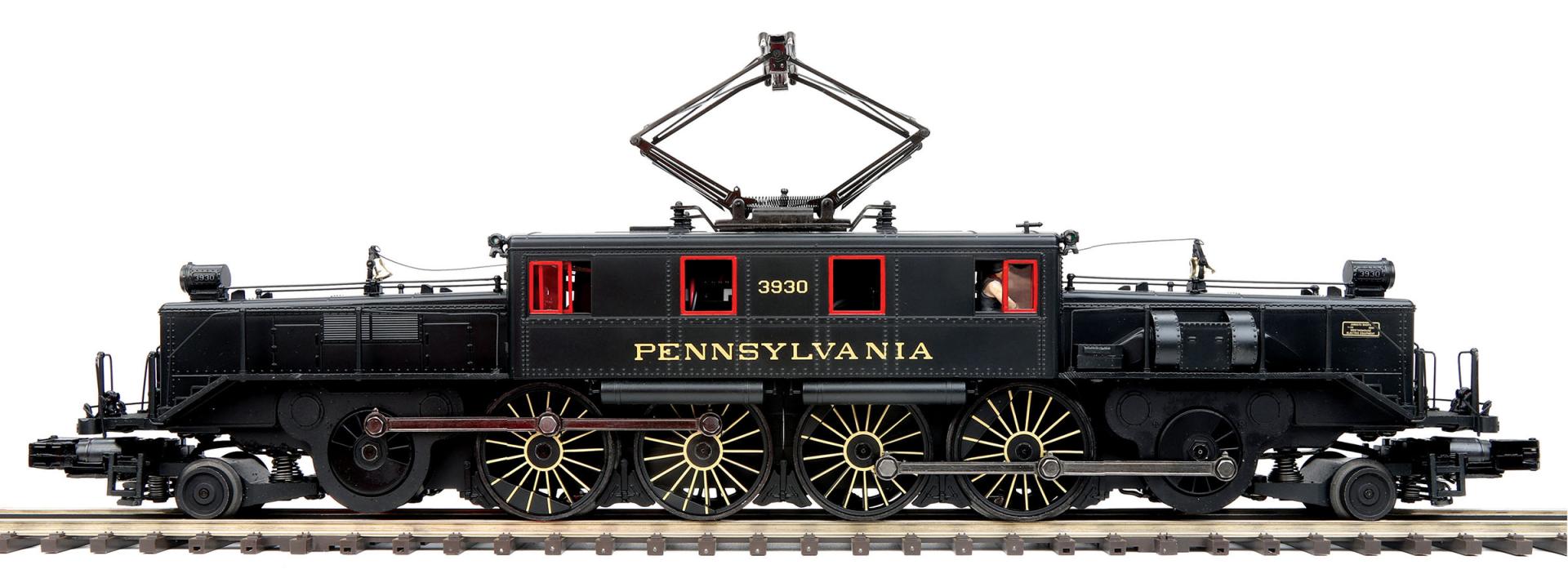
Pennsylvania O Scale Premier L-5 Electric with Proto-Sound 3.0
Overview
By the middle of the Roaring Twenties, the steam engine was a century old but electric power was still new and magical. Wide spread electrification of households had gathered speed only after World War I, and Americans had just begun to buy plug-connected appliances. In the world of railroading, as in Ameri can society at large, many envisioned a world transformed by electricity. The Pennsylvania Railroad, the self-proclaimed Standard Railroad of the World, was just beginning to construct the largest electrified corridor in the United States.
In that world, the Pennsy's new L5 electrics - which look flat-out weird to to 21st century eyes - were right in step with the times. Like most electrical equipment of the era, the L5 was designed to look massive, powerful and solidly dependable. Its dark riveted exterior was a perfect match with the heavyweight passenger cars that had only recently replaced wood rolling stock. In an era before electrical gear was miniaturized, the L5's front and rear hoods concealed four massive motors that turned the two jackshafts that transmitted power through side rods, steam-locomotive style, to the drivers.
First outshopped by the Pennsy's Altoona shops in 1924, the L5 was intended to be a univeral locomotive - equally adept in the road's 600-volt third-rail DC tunnels under the Hudson River, where the two-unit DD1 was king, and on the 11,000 volt overhead AC-powered mainline the Pennsy was just beginning to build. With 80" drivers, probably the largest ever applied to an electric locomotive, the L5 was designed to haul the Pennsy's crack limiteds at 70 mph.
In the end, however, the L5 was a disappointment, and the 24 L5's turned out to be Pennsy's last jackshaft locomotives. Its major downfall was its long, rigid 22' wheelbase - nearly three times that of the successful DD1 - which made it less than nimble over complicated trackwork. (By comparison, the Swiss "Crocodile" electric, another jackshaft electric of the same era, had an articulated wheelbase that made it a highly successful, slow-moving mountain goat that served for decades in the Swiss Alps.)
Another issue with the L5 was weight distrubution: the heavy motors at each end put an inordinate amount of weight over the unpowered end trucks, rather than over the drivers where it could help tractive effort. And in truth, the L5 was also a victim of advancing technology. Within a few years, the advent of smaller, more powerful axle-mounted electric motors would make the Pennsy's magnificent GG1 possible, which was everything the L5's designers had hoped it would be. The L5 fleet soldiered on, however, into the early 1940s, augmenting the DD1's in Penn Station service and doing freight and passenger duties on Philadelphia area mainlines.
Returning to the Premier lineup for 2019, our L5 exhibits none of the problems that plagued the prototype, allowing you to enjoy the L5 doing what it was intended to do: happily ripping down the mainline with a crack express or high-speed freight in tow.
Features
- Intricately Detailed, Die-Cast Metal Body
- Die-Cast Truck Sides & Pilots
- Metal Chassis
- Metal Handrails and Horn
- (2) Handpainted Engineer Cab Figures
- Authentic Paint Scheme
- Metal Wheels, Axles and Gears
- (2) Remote-Controlled Proto-Couplers
- Prototypical Rule 17 Lighting
- Directionally Controlled Constant Voltage LED Headlights
- Lighted LED Cab Interior Light
- Illuminated LED Number Boards
- Lighted LED Marker Lights
- (2) Precision Flywheel-Equipped Motors
- Mechancially Operating Pantographs
- Onboard DCC/DCS Decoder
- Locomotive Speed Control In Scale MPH Increments
- 1:48 Scale Proportions
- Proto-Sound 3.0 With The Digital Command System Featuring Passenger Station Proto-Effects
- Unit Measures: 20 x 2 1/2 x 4 5/8
- Operates On O-72 Curves Diesel DCC Features
- F0 Head/Tail light
- F1 Bell
- F2 Horn
- F3 Start-up/Shut-down
- F4 PFA
- F5 Lights (except head/tail)
- F6 Master Volume
- F7 Front Coupler
- F8 Rear Coupler
- F9 Forward Signal
- F10 Reverse Signal
- F11 Grade Crossing
- F12 Panto Auto/Manual
- F13 Front Panto Up/Down
- F14 Rear Panto Up/Down
- F15 Idle Sequence 2
- F16 Idle Sequence 1
- F17 Extended Start-up
- F18 Extended Shut-down
- F19 Train Marker
- F20 Ditch Light Flash/Std
- F21 One Shot Doppler
- F22 Coupler Slack
- F23 Coupler Close
- F24 Single Horn Blast
- F25 Engine Sounds
- F26 Brake Sounds
- F27 Cab Chatter
- F28 Feature Reset
